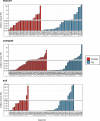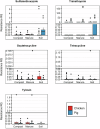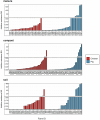Antibiotic ecotoxicity and resistance risks in resource-constrained chicken and pig farming environments
- PMID: 39843536
- PMCID: PMC11721419
- DOI: 10.1038/s44259-024-00071-2
Antibiotic ecotoxicity and resistance risks in resource-constrained chicken and pig farming environments
Abstract
Antimicrobial resistance (AMR) data from agroecosystems in low- and middle-income countries is limited. We surveyed chicken (n = 52) and pig (n = 47) farms in Kenya to understand AMR in animal-environment pathways. Using LC-MS/MS, we validated the methods for analyzing eight common antibiotics and quantified the associated risks. Chicken compost (25.8%, n = 97/376) had the highest antibiotics prevalence, followed by pig manure-fertilized soils (23.1%, n = 83/360). The average antibiotic concentration was 63.4 µg/kg, which is below the environmentally relevant threshold (100 µg/kg), except for trimethoprim (221.4 µg/kg) among antibiotics and pig manure-fertilized soils (129.3 µg/kg) across sample types. Similarly, the average AMR risk quotient (RQ) was low (RQ < 0.1), except for trimethoprim and sulfamethoxazole (RQ ≥ 1). Ecotoxicity and AMR risks increased with flock size and the number of antibiotics used by pigs. Continuous environmental monitoring and large-scale studies on antibiotic contamination are crucial for evidence-based pollution control and the effective mitigation of environmental AMR.
© 2024. The Author(s).
Conflict of interest statement
Competing interests: The authors declare no competing interests.
Figures






Similar articles
-
Tetracycline and fluoroquinolone antibiotics contamination in agricultural soils fertilized long-term with chicken litter: Trends and ravages.Sci Total Environ. 2024 Oct 10;946:174286. doi: 10.1016/j.scitotenv.2024.174286. Epub 2024 Jun 27. Sci Total Environ. 2024. PMID: 38942301
-
Insights into the impact of manure on the environmental antibiotic residues and resistance pool.Front Microbiol. 2022 Sep 16;13:965132. doi: 10.3389/fmicb.2022.965132. eCollection 2022. Front Microbiol. 2022. PMID: 36187968 Free PMC article. Review.
-
Systematic analysis of occurrence, density and ecological risks of 45 veterinary antibiotics: Focused on family livestock farms in Erhai Lake basin, Yunnan, China.Environ Pollut. 2020 Dec;267:115539. doi: 10.1016/j.envpol.2020.115539. Epub 2020 Aug 29. Environ Pollut. 2020. PMID: 32892021 Free PMC article.
-
Spread of antimicrobial resistance genes via pig manure from organic and conventional farms in the presence or absence of antibiotic use.J Appl Microbiol. 2022 Oct;133(4):2457-2465. doi: 10.1111/jam.15717. Epub 2022 Jul 26. J Appl Microbiol. 2022. PMID: 35835564
-
Reducing the Risk of Transmission of Critical Antimicrobial Resistance Determinants From Contaminated Pork Products to Humans in South-East Asia.Front Microbiol. 2021 Jul 27;12:689015. doi: 10.3389/fmicb.2021.689015. eCollection 2021. Front Microbiol. 2021. PMID: 34385984 Free PMC article. Review.
References
-
- Yang, L. et al. Distinct increase in antimicrobial resistance genes among Escherichia coli during 50 years of antimicrobial use in livestock production in China. Nat. Food3, 197–205 (2022). - PubMed
-
- Lewnard, J. A. et al. Burden of bacterial antimicrobial resistance in low-income and middle-income countries avertible by existing interventions: an evidence reviews and modelling analysis. Lancet403, 2439–2454 (2024). - PubMed
-
- Ikhimiukor, O. O., Odih, E. E., Donado-Godoy, P. & Okeke, I. N. A bottom-up view of antimicrobial resistance transmission in developing countries. Nat. Microbiol.7, 757–765 (2022). - PubMed
Grants and funding
LinkOut - more resources
Full Text Sources

